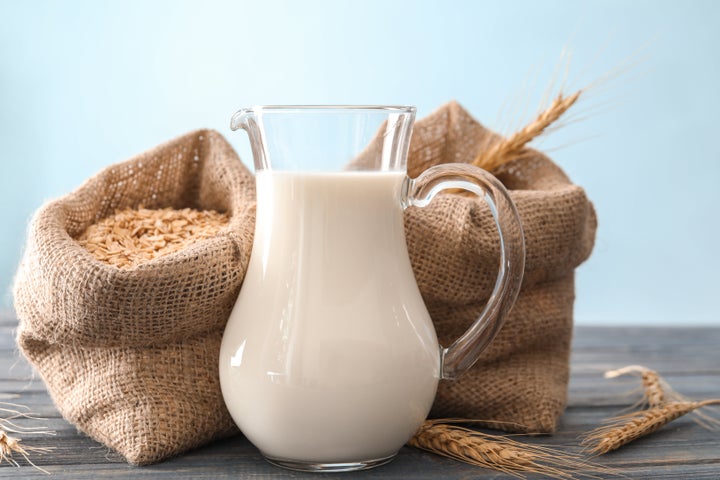
Back in the 1990s, a company called Oatly launched in Sweden. Rickard Öste, Oatly’s founder, discovered that by combining oats, water and a dash of canola oil, he could make a creamy, naturally sweet, dairy-free and gluten-free milk alternative that happened to go perfectly with just about everything. The rest of Europe caught on fairly quickly and 25 years after Oatly opened its doors, the United States joined the party.
Oat milk mania started to catch on in the U.S. in early 2018. It reached a fever pitch this summer — its ability to produce the perfect dairy-free latte has put it in particularly high demand in coffee shops — and baristas and grocery stores everywhere soon found themselves with an oat milk shortage.
As Oatly and other oat milk manufacturers scramble to soak, drain and package their oat milk as quickly as possible, the questions arise: What exactly is oat milk, why is it so delicious and is it good for us? Let’s take a closer look.
Here’s why people can’t get enough of oat milk
By the time non-dairy milks have been mass-produced and splashed on top of our cereal, they’re in pretty good shape. But over the years, it’s taken a lot of trial and error to perfect the process of making soy milk, coconut milk and almond milk with just the right consistency and flavor. It’s also involved a lot of added ingredients, and they’re not always great for us.
Oat milk, on the other hand, is effortlessly tasty: Oats are fibrous and absorb water more easily than nuts do, leading to a naturally creamy consistency. Plus, oats are a little bit sweet, which only adds to oat milk’s deliciousness.
While a handful of companies manufacture oat milk, Oatly is far and away the most popular. D.C.-based nutritionist Lisa Hayim said there’s also something to be said for the marketing around Oatly: It happens to have very cute packaging. “As a nutritionist who gets frustrated by fads and marketing to innocent consumers, this one doesn’t bother me,” said Hayim.
Yes, oat milk is also good for you
Why doesn’t the trendiness of oat milk bother Hayim? Because in addition to tasting great, it’s also packed with nutrition.
“It’s a great addition to the crowded non-dairy nut milk industry because of its unique nutritional composition,” she explained. “Oat milk is going to bring in very little fat, but a bit of carbohydrate and just a small amount of protein. Some of its carbohydrate makeup comes from fiber, and the specific type of fiber could have cholesterol-lowering effects.”
Plus, the fact that oats are naturally a little bit sweet makes it so that adding sugar isn’t necessary to make it taste great. That’s a dream for any nutritionist.
So what about coconut milk, almond milk and soy milk? Should we ditch them altogether in favor of oat milk? Hayim cautions against that, saying that the different non-dairy milks bring different nutrition profiles to the table.
“It’s not that one is ‘better’ or ‘worse’ but the shift in macronutrient compositions should be considered,” explained Hayim. “Soy milk comes from the soybean, so you’re naturally going to get a decent amount of protein that is similar to regular cow’s milk. Almond milk (or any of the nut milks) come from nuts or seeds which are comprised of mostly fat. Depending on the amount of dilution, you’re likely to see a higher percentage of fat found in almond milk compared to oat milk. Coconut milk is also going to be higher in fat but will contain saturated fat.”
While there’s no question that diversity is key nutrition-wise, it’s also worth noting that oat milk may be a more sustainable option than other non-dairy milks. For example, it takes six times more water to grow almonds than oats, according to the Water FootPrint Network. Plus, oat milk is a godsend for people with food allergies: Oats are nut-free and mostly are gluten-free (make sure to check the package, though!).
Like other non-dairy milk, oat milk is sold in the refrigerator aisle and in non-refrigerated boxes. Brands like Elmhurst and Pacific Foods can typically be found in aisles near the boxed soups, while Califia Farms and Oatly are in the refrigerated section near the yogurt and eggs. As a word of warning, boxed non-dairy milks typically have more ingredients in them, but that’s not always the case. Just make sure to be a label detective while you’re picking out your oat milks.
Like most things, you probably shouldn’t overdo it on oat milk. It does have a decent amount of carbohydrates, and carbohydrates break down as sugar in the body. But in general, enjoy every sip of that oat milk latte, because guess what? It’s actually pretty good for you — and the environment.












